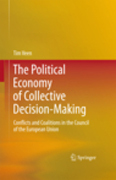
The political economy of collective decision-making: conflicts and coalitions in the Council of the European Union
Veen, Tim
The Council of the European Union is the institutional heart of EU policy-making. But ‘who gets what, when and how’ in the Council? What are the dimensionsof political conflict, and which countries form coalitions in the intense negotiations to achieve their desired policy outcomes? Focussing on collective decision-making in the Council between 1998 and 2007, this book provides a comprehensive account of these salient issues that lie at the heart of political accountability and legitimacy in the European Union. Based on a novel and uniquedataset of estimates of government policy positions, salience and power in influencing deliberations, an explanatory model approximating the Nash-Bargaining solution is employed to predict the policy outcomes on ten policy domains ofcentral importance to this institution. The book's analyses comprise investigations into the determinants of decision-making success, the architecture of the political space and the governments' coalition behavior. Constitutes the first book-length comprehensive analysis of 'who gets what, when and how' in the Council. Analyses a new and original data-set on decision-making in the Council Yields challenging new insights into the dimensions of conflict,. coalition behaviour and winners & losers of collective decision-making. Features a rigorous discussion of the various theoretical and analytical perspectives on political conflict in the Council. INDICE: Preface. 1 Introduction. 2 Analysing Council Decision-Making. 3 Power, Position and Salience. 4 Dimensionality and Nature of Conflict. 5 Coalitions in the Council. 6 Winners and Losers of Decision-Making. 7 The Council: Conflict and Coalitions. References.
- ISBN: 978-3-642-20173-8
- Editorial: Springer Berlin Heidelberg
- Encuadernacion: Cartoné
- Páginas: 210
- Fecha Publicación: 01/07/2011
- Nº Volúmenes: 1
- Idioma: Inglés
